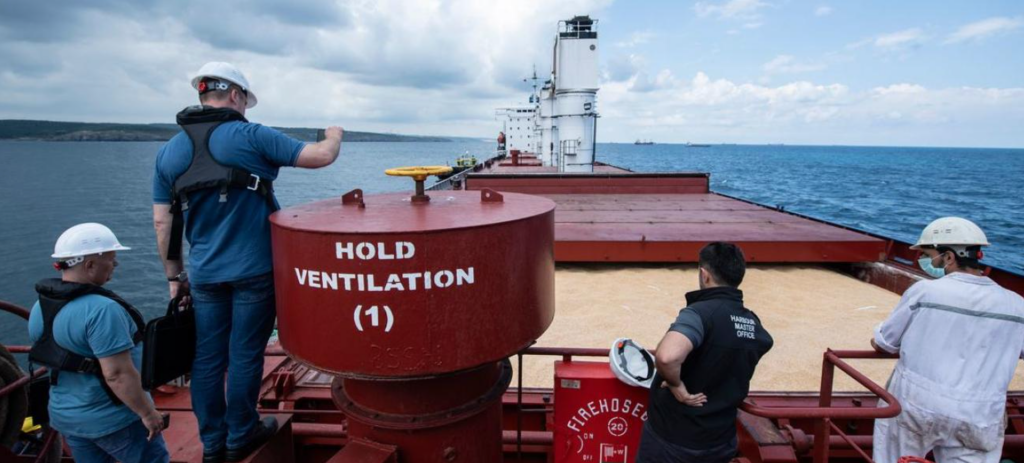The Jordan Center stands with all the people of Ukraine, Russia, and the rest of the world who oppose the Russian invasion of Ukraine. See our statement here.
Susanne Wengle is the N.R. Dreux Associate Professor of Political Science at the University of Notre Dame, and author of “Black Earth, White Bread: A Technopolitical History of Russian Agriculture and Food.”
Vitalii Dankevych is dean of the Faculty of Law, Public Administration, and National Security at Polissia National University, Zhytomyr, Ukraine. He also owns and runs his family’s farm.
Above: The first commercial vessel carrying grain under the Black Sea Grain Initiative. Source
Since Russia’s invasion of Ukraine began on February 24, 2022, Ukrainian farms have been under siege. While the concern about reduced export volumes of Ukrainian food crops is widely shared, it is less well known that agricultural assets are not just collateral damage of a Russian campaign focused on territorial gains. The Russian military is deliberately targeting key farming-related assets and facilities with the aim of inflicting short- and long-term harm. Moreover, by blockading the Black and Azov seas, Russia controls how much Ukrainian grain, oilseeds and other food commodities reach global markets.
The blockade and the purposeful destruction of Ukraine’s agricultural potential not only harm Ukraine’s economy and export earnings, but also gives Russia leverage over its grain trade partners in Africa and Asia, today and in the future. On October 29, when Russia suspended cooperation in the Black Sea Grain Initiative, an international agreement that had allowed passage of Ukrainian food commodities through the Black Sea, wheat futures jumped by nearly 10 percent. After three days of tense negotiations involving Turkey, Russia announced on November 2 that it would temporarily rejoin the agreement. Wheat prices recovered by the end of the day.
Why does Moscow hold such enormous power to sway food prices worldwide?
Ukraine has long been one of the world’s most plentiful breadbaskets. The chernozem, Eurasia’s black earth belt, runs through much of the country. The country’s annual growing seasons are long, and rainfall patterns allow for the cultivation of most industrial food commodities—including wheat, corn, oilseeds, and sugar beets. Given these environmental conditions, the region has fed industrial workers in Europe and the Soviet Union since the early days of the industrial Revolution. Today, Ukraine remains the home of Eurasia’s most fertile and important arable land. In 2021, the agricultural sector accounted for more than 10 percent of Ukraine’s GDP, and for 41 percent of exports.
Since the onset of war, the harm Russian occupying forces have inflicted on Ukrainian farms, as well as facilities connected to agricultural production and export, has been extensive and targeted. There are at least four types of critical damage to agricultural assets that merit broader attention by scholars and policymakers. The first type is theft. Russian troops are reported to have stolen various types of grain and agricultural machinery from occupied territories. The second type of damage relates to the disruption of the current growing season due to the lack of access to agricultural inputs and the diversion of farm labor. Since this fall's harvest season, intentional burning of crops is also part of this category.
A third type of harm is the ruination of agricultural infrastructure. This includes damage to farmland (due to bombings and mines) and the destruction of machinery, irrigation systems, grain storage elevators, transport infrastructure, and other assets. This category, damage to infrastructure, is likely to be the most significant in terms of their long-term costs.
A fourth type of damage is related to Russia’s blockade of the Black Sea and the Sea of Azov, the export routes for the bulk of Ukrainian food commodity crops. This fourth category is currently the most harmful. Russia has used the blockade of Ukraine’s sea trade routes as an effective tool not only to limit and control Ukraine’s ability to export agricultural commodities to global markets, but also to extract concessions to the sanctions regimes in negotiations with the West.
The Black Sea Grain Initiative (BSGI)—signed by Ukraine, Russia, and Turkey on July 22, 2022, and supported by the UN—established the parameters of a so-called grain corridor, a partial easing of the naval blockade that created a way for Ukrainian food crops to reach world markets. While the BSGI has allowed Ukraine to export a significant share of last year and this year’s harvest, many millions of tons of grain are still stuck in Ukraine, awaiting export, and have thus failed to reach the low- and middle-income countries in Asia and Africa that rely on this grain.
While the BSGI is not perfect, it is also a better-than-nothing solution, since it is nearly impossible for Ukraine to export significant amounts of grain via rail and road. The current agreement expired on November 19, but luckily an agreement on the renewal of the BSGI for a further 120 days had been reached two days earlier. As it had in July, Turkey played the most important role in brokering an agreement between Ukraine and Russia.
In sum, Russia holds enormous power over food prices because Ukraine and the Black Sea region are crucial contributors to world grain markets. While a new, limited agreement was recently reached to keep the grain corridor open, as long as Russia’s Black Sea blockade remains in effect, it will constitute an effective blackmail opportunity that the country will is likely to exploit.



